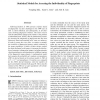Free Online Productivity Tools
i2Speak
i2Symbol
i2OCR
iTex2Img
iWeb2Print
iWeb2Shot
i2Type
iPdf2Split
iPdf2Merge
i2Bopomofo
i2Arabic
i2Style
i2Image
i2PDF
iLatex2Rtf
Sci2ools
AUTOID
2005
IEEE
2005
IEEE
Statistical Models for Assessing the Individuality of Fingerprints
Following Daubert in 1993, forensic evidence based on fingerprints was first challenged in the 1999 case of USA vs. Byron Mitchell, and subsequently, in 20 other cases involving fingerprint evidence. The main concern with the admissibility of fingerprint evidence is the problem of individualization, namely, that the fundamental premise for asserting the uniqueness of fingerprints has not been objectively tested and matching error rates are unknown. In order to assess the error rates, we require to quantify the variability of fingerprint features, namely, minutiae in the target population. A family of finite mixture models has been developed in this paper to represent the distribution of minutiae in fingerprint images, including minutiae clustering tendencies and dependencies in different regions of the fingerprint image domain. A mathematical model that computes the probability of a random correspondence (PRC) is derived based on the mixture models. A PRC of 2.25 × 10−6 co...
| Added | 24 Jun 2010 |
| Updated | 24 Jun 2010 |
| Type | Conference |
| Year | 2005 |
| Where | AUTOID |
| Authors | Sarat C. Dass, Yongfang Zhu, Anil K. Jain |
Comments (0)

